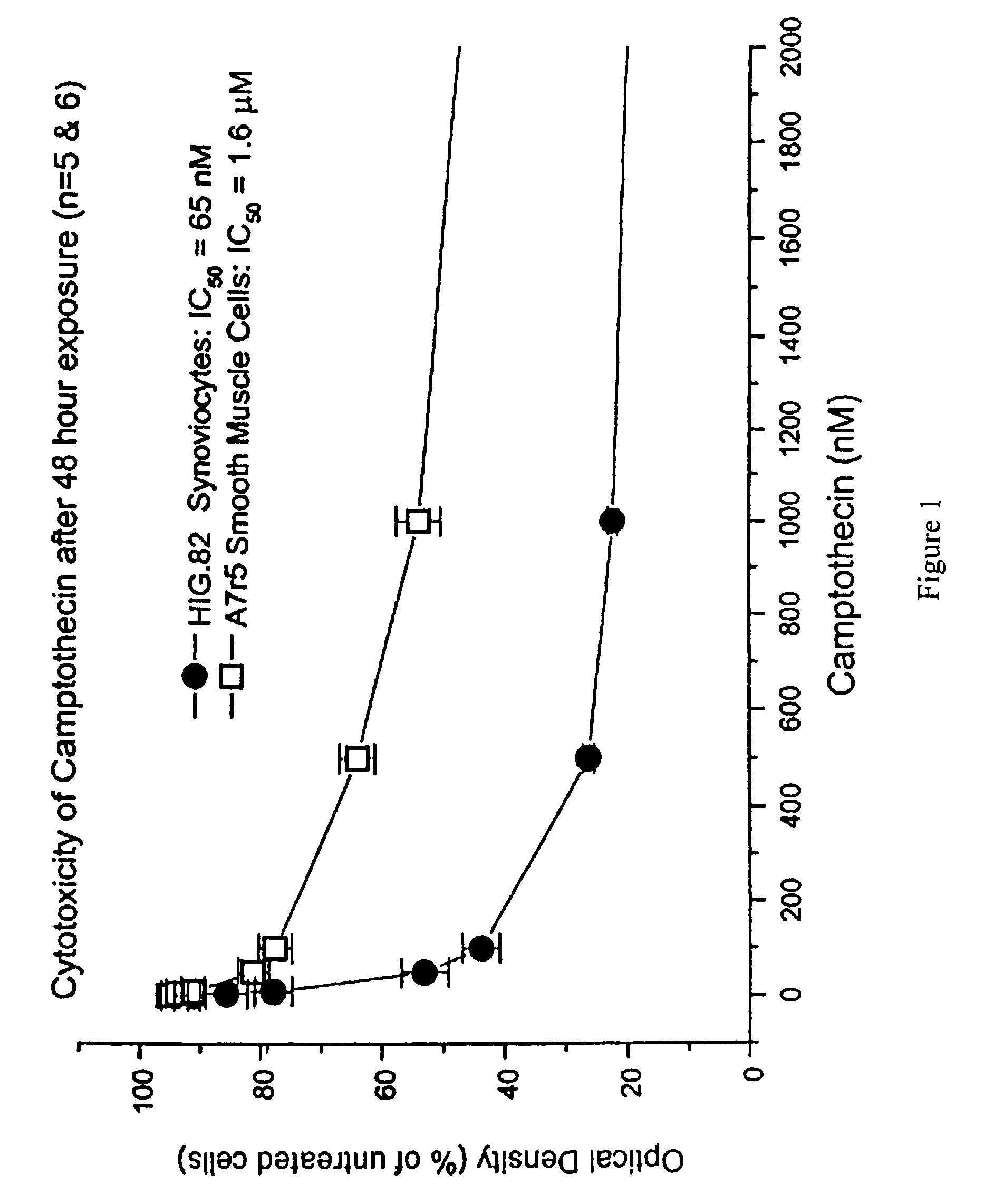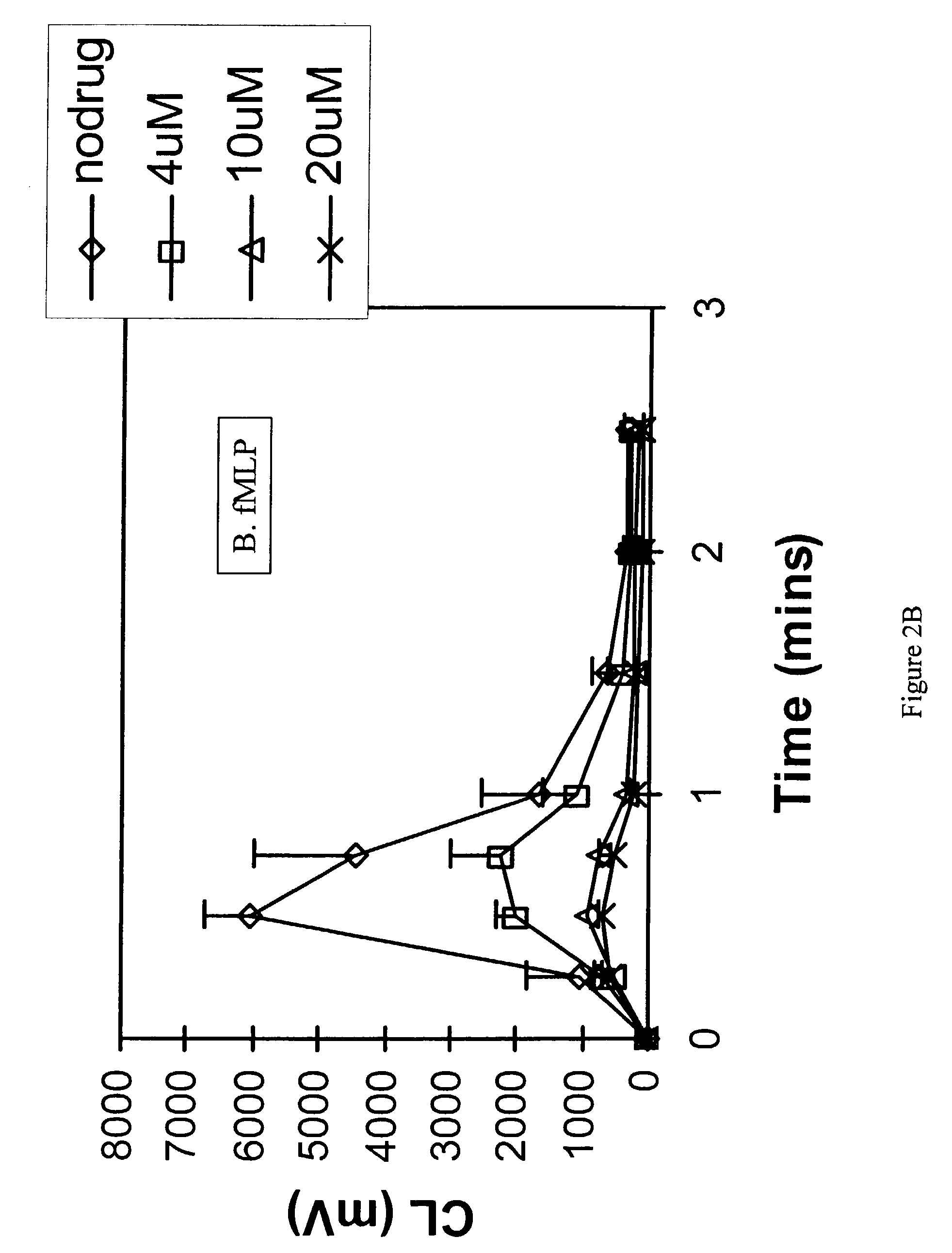Compositions and methods for the treatment of inflammatory diseases using topoisomerase inhibitors
a technology of inflammatory diseases and compositions, applied in the field of compositions and methods for the treatment of inflammatory diseases using topoisomerase inhibitors, can solve the problems of limited treatment options for patients, limited clinical application prospects, and large present cost of treating inflammatory diseases around the world, so as to reduce toxicity, reduce systemic or local toxicity, and effective inhibitory activity
- Summary
- Abstract
- Description
- Claims
- Application Information
AI Technical Summary
Benefits of technology
Problems solved by technology
Method used
Image
Examples
example 1
The Effect of Camptothecin on Synoviocyte and Smooth Muscle Cell Proliferation in vitro
[0101]Proliferation was determined using the MTT proliferation / cytotoxicity assay.
[0102]On day one, 1500-2000 smooth muscle cells (A7r5 rat embryonic thoracic aorta) or synoviocytes (HIG.82 rabbit) were plated per well on a 96-well plate, leaving the first column free of cells (blank). The plate was placed back into the 37° C., CO2 incubator. The following day camptothecin was added at various concentrations. No drugs were added to the first column (blank) and the second column (untreated column) for control. The cells were exposed for 24, 48, and 72 hours. At the end of the exposure period, 50 μl of dimethylthiazol diphenyltetrazolium bromide salt (MTT) dissolved in media was added and allowed to incubate for 4 hours at 37° C. The medium was then aspirated and 200 μl of dimethyl sulfoxide was added. The plate was agitated for 30 minutes and the absorbance read at 562 nm. The optical density measu...
example 2
The Anti-inflammatory Effects of Camptothecin and Other Topoisomerase Inhibitors in an in vitro Model of Arthritis: The Induction of Apoptosis in Neutrophils
[0106]The inflammation associated with many forms of arthritis is thought to arise from the presence of large numbers of immune cells, such as neutrophils, in the synovial joints of humans. The extended inflammation associated with crystal induced arthritis arises from the interaction of neutrophils with crystals in the synovial joint. One reason the extended duration of the inflammation in this disease may be due to the inhibition of neutrophil apoptosis by crystals. This inhibition may result in the neutrophils remaining in the joint for extended periods. Compounds that overcome this crystal induced suppression of neutrophil apoptosis therefore allow the more rapid clearance of these cells from the joint with the appropriate abatement of inflammation. The process of apoptosis involves the endonuclease driven cleavage of DNA in...
example 3
The Effect of Topoisomerase Inhibitors on Neutrophil Chemiluminescence
[0111]Freshly prepared human neutrophils were incubated with the compound followed by stimulation of the cells with either plasma opsonized CPPD crystals, the bacterial chemoattractant, fMLP or the phorbol ester, PMA. Stimulation (or activation) of the cells induced superoxide anion generation which could be measured by the emission of light (chemiluminescence). Inhibition of neutrophil function was then determined by inhibition of chemiluminescence. Hanks buffered salt solution (HBSS) pH 7.4 was used throughout the study. All chemicals were purchased from Sigma Chemical Co. (St. Louis, Mo.) unless otherwise stated. All procedures were performed at 37° C. unless otherwise stated. CPPD (triclinic) crystals were prepared and characterized as previously reported (Jackson J K et al., J Rheumatol, 24: 341-348, 1996). The size distribution of the crystals was approximately 33% less than 10 mm, 38% between 10 and 20 mm a...
PUM
| Property | Measurement | Unit |
|---|---|---|
| Inhibition | aaaaa | aaaaa |
| Inhibition | aaaaa | aaaaa |
| Inhibition | aaaaa | aaaaa |
Abstract
Description
Claims
Application Information
 Login to View More
Login to View More - R&D
- Intellectual Property
- Life Sciences
- Materials
- Tech Scout
- Unparalleled Data Quality
- Higher Quality Content
- 60% Fewer Hallucinations
Browse by: Latest US Patents, China's latest patents, Technical Efficacy Thesaurus, Application Domain, Technology Topic, Popular Technical Reports.
© 2025 PatSnap. All rights reserved.Legal|Privacy policy|Modern Slavery Act Transparency Statement|Sitemap|About US| Contact US: help@patsnap.com



